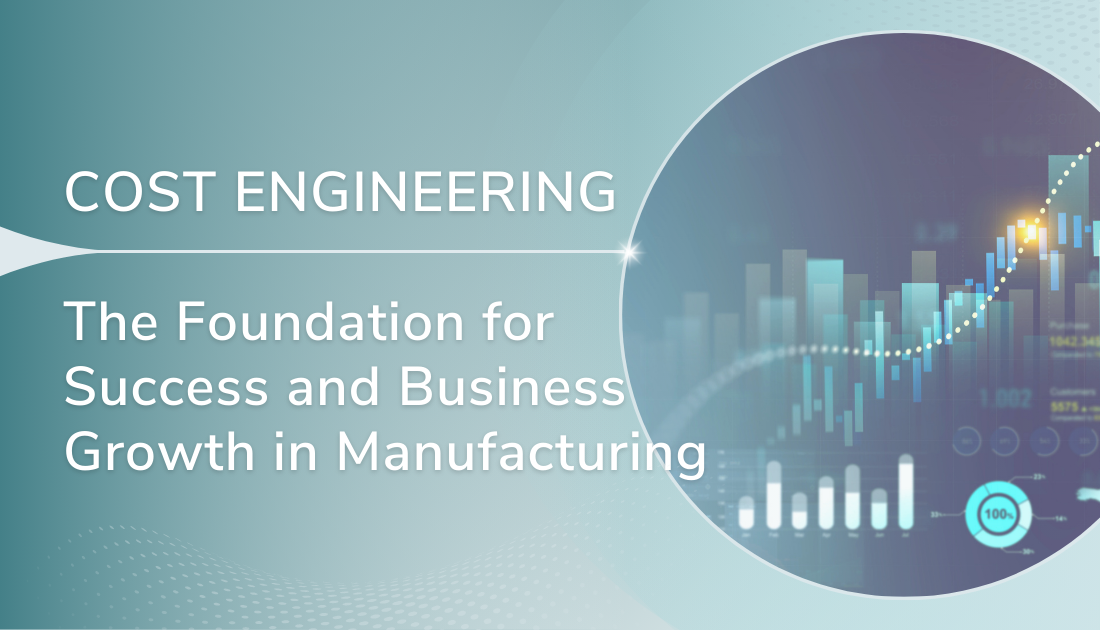Businesses today face constant cost pressures, with every decision closely examined to safeguard profit margins.
Suppliers must operate near their customers’ locations while adhering to just-in-time production processes. On top of this, they face constant cost pressures from customers, including extended payment terms, risk liability, demands for ‘quick savings,’ and ‘pay to play’ schemes.
Decades of complex challenges in automotive and advanced manufacturing have cemented cost engineering as a central practice. This discipline takes a whole-lifecycle approach—balancing costs from procurement and manufacturing to assembly and in-service support.
Our article explores how cost engineering keeps manufacturing customer-focused and economically sustainable.
CONTENT
- What is cost engineering, and what are its key components?
- What does a cost engineer do?
- Four tell-tale signs it’s time to rethink your cost engineering approach
- EPC for successful cost engineering
WHAT IS COST ENGINEERING, AND WHAT ARE ITS KEY COMPONENTS?
Cost engineering is widely used in industries such as manufacturing, construction, energy, and automotive. Here is what cost engineering entails:
Cost engineering in a nutshell
Cost engineering is a central discipline dedicated to managing project costs across every phase of a product’s life cycle, from the design stage to production.
By examining costs at each step, cost engineers uncover valuable opportunities for savings—often areas that might be missed with a more limited or fragmented approach.
Cost engineering integrates financial analysis with technical expertise to improve quality, optimize efficiency, and maximize profitability at every stage of a project.
PRINCIPLES OF COST ENGINEERING IN MANUFACTURING
Cost engineering serves as a strategic framework to manage expenses effectively throughout the manufacturing lifecycle.
By adopting a comprehensive perspective, manufacturers can move beyond cutting costs for individual components and focus on optimizing overall performance. A well-defined cost engineering approach encompasses the following principles:
- The primary aim of cost engineering is to achieve measurable cost savings that positively impact the bottom line in manufacturing.
- Cost engineering also acts as a unifying tool. It brings together cross-functional teams to design and implement cost-effective product specifications collaboratively.
- Cost engineering takes a comprehensive approach. It addresses all cost elements across the manufacturing value chain, from materials and production to logistics and disposal.
- It is not a standalone task; it integrates seamlessly into every product lifecycle stage, from initial concept to end-of-life management.
Watch our video to learn about cost engineering.
WHAT DOES A COST ENGINEER DO?
Cost engineering ensures project costs are well-estimated, controlled, and analyzed to drive strategic decision-making and optimize outcomes.
The role of cost engineers in manufacturing
Imagine a manufacturing company is designing a new product.
The development team might focus on selecting the most durable material for a component, while the purchasing team prioritizes minimizing costs by sourcing cheaper materials.
This could lead to unexpected problems, such as selecting a too—expensive material or choosing a cheaper option that fails during production.
A cost engineer bridges this gap by evaluating the technical requirements (e.g., durability, manufacturing constraints) and the financial implications (e.g., material costs, supplier availability) to recommend the best overall solution. This ensures that the product is both cost-effective and technically sound.
Here’s what a cost engineer is responsible for:
Cost estimation
Cost estimation involves forecasting the financial resources needed to complete a project.
This process accounts for all expenses, such as materials, labor, equipment, and overhead. Accurate estimation ensures proper budgeting and resource allocation, reducing risks associated with underfunding or overspending.
One of the key methods of cost engineering in manufacturing is should-cost analysis.
Should costing in a nutshell
Should costing is a way to determine how much something should cost before it is designed.
This helps purchasing teams set a fair price and negotiate better deals with suppliers.
Cost control
Cost control ensures that project spending remains within budget throughout its lifecycle.
This involves:
- Tracking expenditures
- Comparing actual costs with planned ones
- Identifying discrepancies
- Taking corrective measures to avoid overruns
Cost analysis
Cost analysis evaluates cost data to support decision-making and optimize project outcomes. It includes:
- Conducting cost-benefit analyses to assess the feasibility of project alternatives
- Performing lifecycle costing to evaluate the long-term financial impact of decisions
- Analyzing cost drivers to identify areas for improvement.
FOUR TELL-TALE SIGNS IT'S TIME TO RETHINK YOUR COST ENGINEERING APPROACH
Failing to involve the entire organization in the cost-engineering process creates multiple issues. Cost-reduction opportunities may be overlooked, and savings in one area can drive up costs in another. From experience, these challenges often arise from four key underlying causes.
1. Different perceptions of goals
As simple as it may sound, management must determine the general business goals and agree on clearly defined corporate guidelines: Which goals should be reached by when? What priority do they have? How do we achieve our goal?
The departments involved should be aware of these goals. It is necessary to secure their commitment, e.g., through workshops in small groups.

2. Different perceptions of costs
Controlling, Purchasing, R&D, Sales, and Management often hold varying perceptions of costs, even while working toward a shared organizational goal.
This misalignment stems from individual priorities and an isolated understanding of cost factors. It is further exacerbated by disconnected or specialized tools like CAD, ERP, PLM, and BI systems, which focus on specific functions instead of delivering holistic cost transparency.
For instance, PLM tools handle technical data but can only calculate basic cost totals. ERP systems rely on historical, transaction-heavy data that fail to account for future parameters.
This fragmented approach leads to inefficiencies and inhibits profit-driven decision-making.
FACTON EPC offers a single solution for seamless collaboration across departments. With EPC, costs are integrated into every stage of product development, fostering transparency and aligning objectives. This cohesive approach drives greater profitability through efficient costing and quoting.
3. Overanalyzing costs
Some manufacturers lose focus by aiming for overly detailed cost models rather than actionable ones:
The goal of cost engineering is not just to spot potential savings but to implement them effectively. Simplified cost estimates can spark meaningful discussions with suppliers and across teams without heavy calculations.
Adopting tools that provide quick, accurate overviews empowers informed decision-making. FACTON makes it easy for manufacturing professionals to access a first cost estimate without extensive calculation expertise quickly.
4. Inability to scale
Scaling cost-engineering efforts beyond a single department is a significant challenge.
Manufacturing companies must introduce new practices across multiple locations and teams, which requires strong leadership, targeted tools, and efficient processes.
Success depends on consistent executive support and a structured approach to change management that ensures seamless adoption across the enterprise.
- Calculation scheme: calculation schemes in Manufacturing.
- Price calculation: calculate competitive sales prices.
- Strategic procurement: eleven best practices.
- Quotation management: efficient data handling for automotive suppliers.
EPC FOR SUCCESSFUL COST ENGINEERING
Collaborating on reliable profitability and growth targets requires a unified, enterprise-wide approach to total cost management. Enterprise Product Costing (EPC) provides this solution with a fully integrated and standardized method for product costing.
EPC is built on three key pillars:
- Standardized costing methods
- Cost tracking and optimization across the entire product life cycle
- Integration of all cost-relevant data into enterprise-wide IT systems
This approach spans every key area of the company—from development and value engineering to purchasing, sales, and supply chain management, all the way to controlling and executive oversight.
By focusing on costs at every stage and phase of a product's life cycle EPC empowers businesses to optimize costs early and maintain control.
BENEFIT OF EPC FOR EXTERNAL SUPPLIERS AND CUSTOMERS
An enterprise-wide cost engineering approach not only brings departments within a company closer together but also builds a solid relationship with external suppliers and customers.
Transparent product costing is the building block for presenting sound arguments and conducting price negotiations.
Below are two key use cases drawn from our manufacturing customers.
Use case 1: cost calculations for existing customers.
When working with repeat customers, new cost estimates must align with previous quotation calculations
If there’s a significant difference between the new and old calculations, the sales representative must explain the disparity.
An effective cost management solution ensures that costs are presented clearly and reliably. This includes detailed visibility into investments such as tools and machinery. The ability to track cost changes at every stage is crucial. It makes it easier to spot differences and understand the impact of customer change requests, which may require renegotiation.
Use case 2: open book accounting.
Open book accounting, though beneficial, can be controversial, particularly in the automotive industry. It requires suppliers to share their costing structure transparently.
This approach comes with risks. Customers may identify errors, inconsistencies, or potential cost-saving opportunities. These findings can sometimes be used to pressure suppliers into reducing prices.
To mitigate this, management must strategically approach open book accounting.
Negotiations can remain objective and constructive by focusing discussions on the costs of specific components rather than overall pricing. Suppliers can clarify cost structures in detail with tools like EPC, ensuring transparency without exposing vulnerabilities.
Listen to the podcast to find out more about the benefits of cost engineering.


.jpg?width=2100&height=450&name=Blog_Banner_WP_EPC%20(2).jpg)
